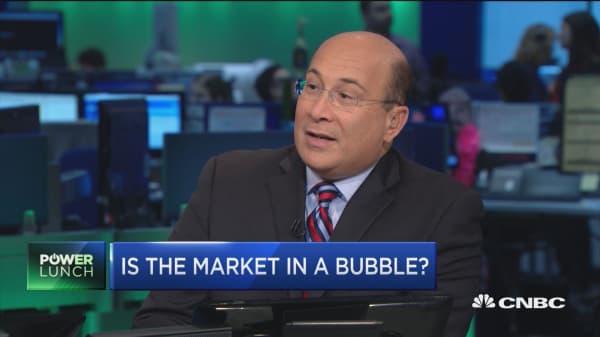The "bubble boys" are back in droves. From global investor Marc Faber, who said on CNBC Tuesday that U.S. stocks could fall some 50 percent from current levels, to Republican presidential nominee Donald Trump, who recently claimed stocks are in a bubble and that he wouldn't invest in the market, the gloom and doomers are flashing warnings signals!
Whether or not it is appropriate for a presidential candidate to express doubt about the safety and soundness of U.S. financial markets will be left for others to decide.
Let's deal with the issue at hand. Is the U.S. stock market in a bubble?
It is true that market valuation are stretched, sitting as they are against a backdrop of declining corporate profits; soft economic growth, both here and abroad; interest rate policy reaching the limits of its efficacy abroad; and the threat of interest rate increases here at home.
Stocks have, however, remained stubbornly resilient. The S&P 500 and NASDAQ have just days ago scored all time highs and the Dow Jones Industrial Average remains within striking distance of a record.
That said, there are signs of strain in the market. Internal technical indicators are not as strong as one would like if, indeed, stocks were poised for a new, secular, or long-term leg upwards.
Stock market leadership is coming from very defensive, or "recession resistant" groups like healthcare and consumer staples, rather than from faster growing sectors like technology, financials and consumer discretionary issues.
The folks at Ned Davis Research, one of the most widely respected research houses around, just tweeted out some data that warrant consideration, suggesting that on a relative basis, stock market valuations look ok.
However, on an absolute basis, in other words, when compared to other pricey periods in stock market history, the market looks stretched.
NDR notes that when price to earnings ratios are above 20, as they are today, the market has about as much chance of going up 12 months hence as it has of going down.
Further, P/E ratios are as high as they have been at any time since 2007. Only in 2000 were P/E ratios higher than they are now or in 2007.
Tweet
NDR's recommendation is to take some protective measures. That could mean buying protective put options on individual stocks or the market as a whole. It could also mean taking profits on stocks that have shot up and whose valuations are stretched.
Many experts suggest selling out the initial investment and playing with house money so that one's capital is safe.
Of course, the bears have suggested for years that this market is due for a serious decline. And we have had several corrections since this bull market began on March 9, 2009.
I am not in the bubble camp, but I am growing more cautious about the state of the stock market.
There are other issues to be concerned about regarding the financial markets. Certain credit spreads have widened, indicating signs of strain in the global financial system. British and European interest rates, Tuesday, fell to record lows. That is also indicative of weak growth overseas and a potential negative for future profit growth here at home.
European banks are under duress. Japan, China, Russia, Saudi Arabia, Brazil and Venezuela have varying degrees of economic distress.
Goldman Sachs recent told clients to stay away from stocks for the next three months. That's a trading tactic, not an investment strategy.
Walt Disney looks good again. And other strong, brand name franchises remain solid long-term investments.
Things can change. If the Fed raises rates persistently in the months ahead, we will quickly find out if there are system strains in the market.
Unless, or until, that occurs, the market is stretched, but a crisis, is not yet in the making. Never say never, but the signs that flashed red before the last crisis are, at best, flashing yellow right now.
If the light changes, I hope to be the first standing on the corner yelling, "STOP!"




